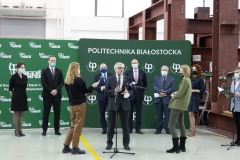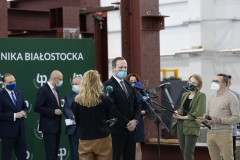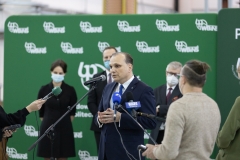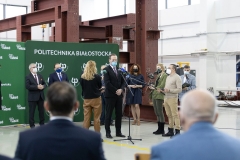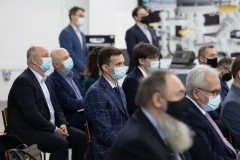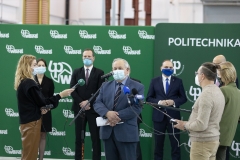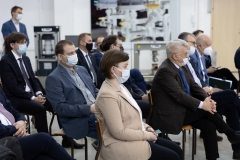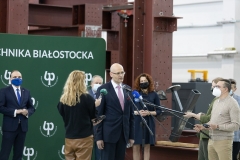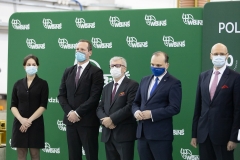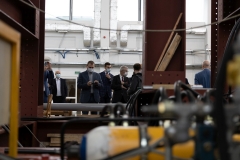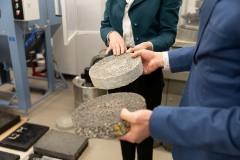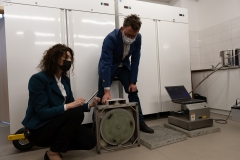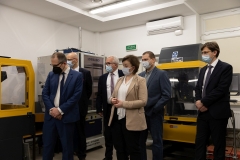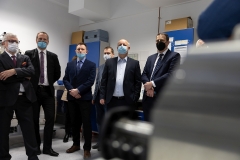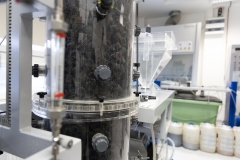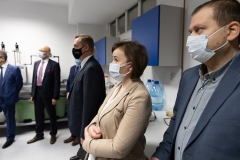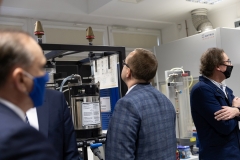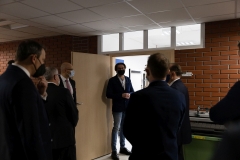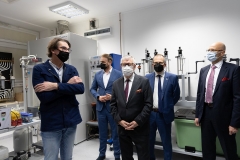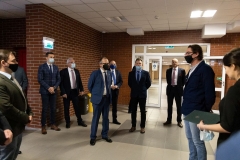Bialystok University of Technology in cooperation with Lafarge
19-01-2022
– 70 years of experience in education and conducting scientific research is a potential that needs to be developed and used effectively,” said Assoc. Prof. Marta Kosior-Kazberuk, DSc, PhD, Eng, Rector of Bialystok University of Technology. – Our activities should result in joint projects that are important for the economy. Creating breakthrough innovations and responding to real needs of the economy requires linking numerous units, sharing experience and exchanging resources. I hope that this meeting will lead to such solutions, and that it will result in numerous projects attractive not only to us, but also to the socio-economic environment in general. I think that we have a good chance of success here.
The meeting, which was initiated by Minister Wojciech Murdzek in December last year in the Ministry of Science and Higher Education, was aimed at establishing real cooperation between Polish science, entities representing the State Treasury and business circles. Representatives of the Łukasiewicz Research Network represent eight thousand employees, 28 research institutes located in 12 Polish cities. It is the third largest research network in Europe.
– The level of research projects between science and business is PLN 7.5 billion, where PLN 1.8 billion is on the part of the
Łukasiewicz Research Network and the remaining amount is financed by entrepreneurs – said Marcin Kruk, PhD, Eng, Leader of the Łukasiewicz Modular Constructure Research Programme, Director of Łukasiewicz Institute of Mechanised Construction and Rock Mining. – This shows that cooperation, building a consortium, gives the future.
The Łukasiewicz Research Network, leading the modular construction research programme, integrates five thematic blocks: innovative, modern building materials, responsible for deep thermo-modernisation, automation and robotisation in industry, recycling, processing, as well as energy efficiency and intelligent buildings.
– I look with admiration at the potential of the Faculty of Civil Engineering and Environmental Sciences of Bialystok University of Technology, because at the level of many faculties we have a huge area for cooperation,” said Marcin Kruk.
Prefabricated and modular constructions have been researched by the Faculty of Civil Engineering and Environmental Sciences of Bialystok University of Technology for years.
– For years, we have been studying timber frame modular construction – emphasised Prof. Czesław Miedziałowski from the Department of Geotechnics and Mechanics of Structures at the Faculty of Civil Engineering and Environmental Sciences of BUT.
Bialystok University of Technology studies prefabricated modular houses produced in house factories and examines them at every stage – from transport to the construction site to building and working on the finished structure.
– Wood is a very interesting material, but difficult, prone to deformation – recalled Prof. Miedziałowski. – We have already carried out research on a wooden modular building with four storeys. We benefit from cooperation with companies that are in our area. We have a well-equipped Inno-Eko-Tech hall adapted for studying life-size elements.
Professor Miedziałowski disclosed that scientists from the University are already consulting a wooden modular building with eight floors.
The design and execution of infrastructure and road investments are the core business of LH Engineering, a subsidiary of Lafarge Polska.
– Working with both the Łukasiewicz Research Network and Bialystok University of Technology, we aim at solving technical problems in three areas – announced Łukasz Marcinkiewicz, General Manager of Lafarge Holcim Engineering and Infrastructure Solutions. – The first area is sustainable construction, that is, construction that is energy efficient, the second is digitalization and the third element is automation. I hope that the projects which we are going to implement together will make it possible to modernise the construction industry, and in the field of infrastructure construction to bring the road construction industry into the 22nd century. This means more digitalisation, more automation, more authoritative and reliable research, but also sustainability and the use of recycled materials.
Modern infrastructure requires modern materials, binders and aggregates which are produced or obtained with respect for the natural environment. Unique solutions are supervised by the Łukasiewicz Institute of Ceramics and Building Materials.
– Research work on the development of modern building materials, which the Łukasiewicz Network could conduct jointly with Bialystok University of Technology, should be focused on: low-emission in the process of materials’ production; the use of waste raw materials or post-production by-products from other industries, decarbonised – replacing or limiting the use of natural raw materials; improving mechanical properties and durability of the developed materials, as well as energy-saving in their use while maintaining economic competitiveness, said Paweł Pichniarczyk, DSc, PhD, Eng, Leader of the Łukasiewicz Competence Centre Construction, Director of the Łukasiewicz Institute of Ceramics and Building Materials. – I am convinced that valuable experience, a team of people working both at Bialystok University of Technology and the Łukasiewicz Network, as well as excellent research facilities, will create, develop and implement, together with Lafarge, projects generating innovative material technologies. This is what we will be doing in the coming years.
Lafarge declares that it will soon stop producing the most energy-intensive pure cement in favour of multi-component cements.
– There is a great challenge ahead of us to save natural resources for future generations and to apply a closed-circuit economy in the full sense of the word, stressed Stanisław Sobczyk, Industrial Director, Vice-President of Lafarge Polska. – We can see great space for cooperation between science and industry.
Bialystok University of Technology boasts a patent for recycling concrete rubble, but the scope of research conducted by our scientists from the Faculty of Civil Engineering and Environmental Sciences is much greater. From the aforementioned recycling, the use of fly ash, through the application of multi-component cements, innovative concrete road surfaces to the search for alternative binders.
– At the Faculty of Civil Engineering and Environmental Sciences, we have been successfully working with the closed loop economy for over 30 years. We use forestry waste, waste from the agro-food industry, industrial waste, concrete rubble, said Katarzyna Kalinowska-Wichrowska, PhD, Eng, Vice Dean for Development and Cooperation at the Faculty of Civil Engineering and Environmental Sciences, Department of Construction and Road Engineering. – We are successfully reintegrating them into the construction production process. We have also patented a comprehensive method for recycling concrete rubble to produce high-quality coarse aggregate that can be recycled back into concrete and can replace natural aggregate one hundred percent. We have also developed methods for reinforcing structures with protective layers of special concretes, geopolymer concretes that are also environmentally friendly, and technologies for manufacturing construction products using organic fillers. We are fully prepared in all areas related to closed-cycle economy with the use of waste raw materials. We have appropriate research and laboratory facilities, human potential and experience.
The result of the working meeting at Bialystok University of Technology may be the formation of a consortium that will develop specific solutions to contribute to the practical implementation of further innovative and sustainable construction solutions with a low carbon footprint, which allow a faster and more efficient construction process using digital solutions in a way that is friendly to people and the planet.
The conference was attended by:
– Assoc. Prof. Marta Kosior-Kazberuk, DSc, PhD, Eng., Rector of Bialystok University of Technology
– Łukasz Marcinkiewicz, General Manager of Director of Lafarge Holcim Engineering and Solutions for Infrastructure
– Stanisław Sobczyk, Industrial Director, Vice-President of Lafarge Poland
– Marcin Kruk, PhD, Director of the Łukasiewicz Institute of Mechanised Construction and Rock Mining
– Paweł Pichniarczyk, PhD, Director of the Łukasiewicz Institute of Ceramics and Building Materials
– Prof. Czesław Miedziałowski – Department of Geotechnics and Mechanics of Structures, Faculty of Civil Engineering and Environmental Sciences, BUT
– Katarzyna Kalinowska-Wichrowska, PhD, Eng, Department of Construction and Road Engineering, Faculty of Civil Engineering and Environmental Sciences
(jd)



